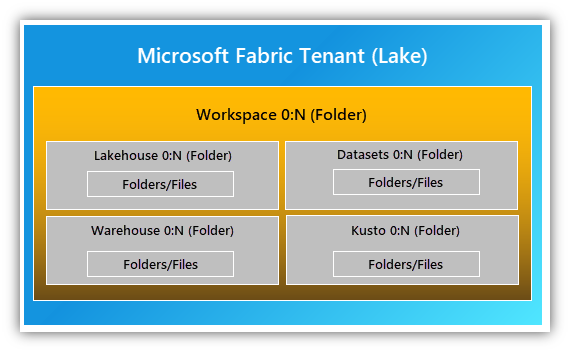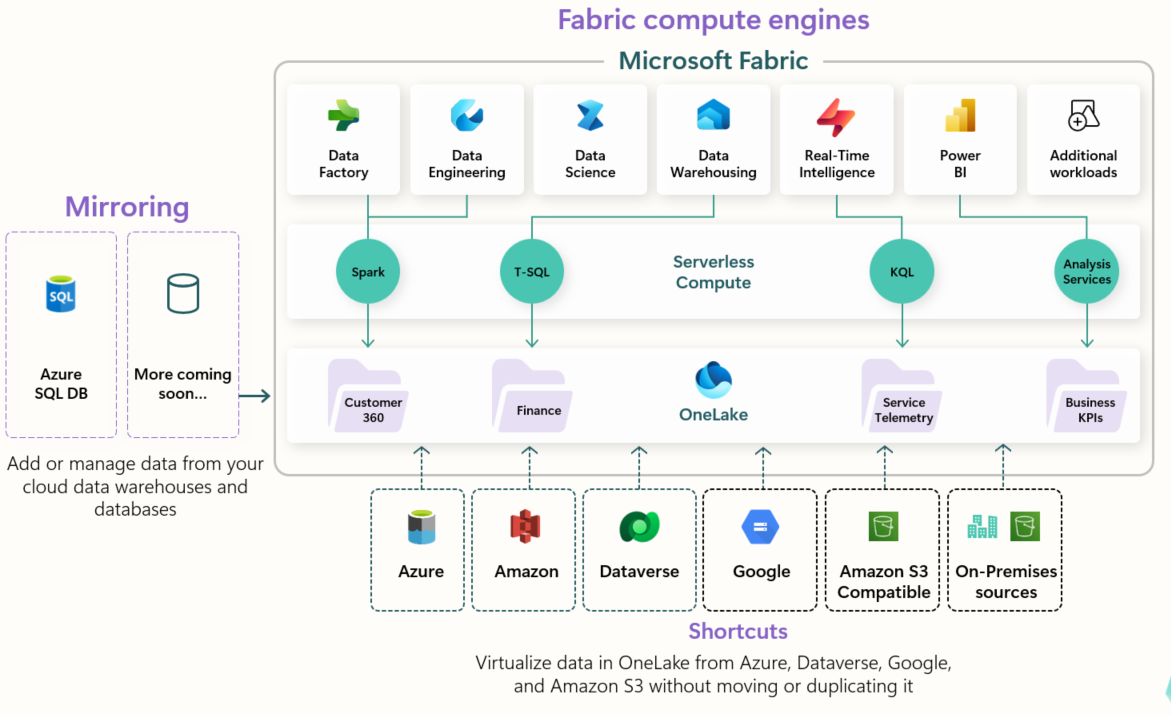Co je Microsoft Fabric?
Microsoft Fabric je komplexní analytická platforma připravená pro podniky. Sjednocuje přesun dat, zpracování dat, příjem dat, transformaci, směrování událostí v reálném čase a vytváření sestav. Podporuje tyto funkce s integrovanými službami, jako jsou Datové inženýrství, Data Factory, Data Science, Real-Time Intelligence, Data Warehouse a Databáze.
Fabric poskytuje bezproblémový a uživatelsky přívětivý SaaS zážitek. Integruje samostatné komponenty do soudržného technologického stacku. Centralizuje úložiště dat pomocí OneLake a vkládá funkce AI, což eliminuje potřebu ruční integrace. Pomocí platformy Fabric můžete efektivně transformovat nezpracovaná data na prakticky využitelné přehledy.
Poznámka
Jste nový vývojář, který pracuje s Fabric? Máte zájem podělit se o své zkušenosti s počátky a pomoci nám zlepšovat? Rádi bychom s vámi mluvili! Zaregistrujte se zde, pokud vás zajímá.
Možnosti tkániny
Microsoft Fabric zvyšuje produktivitu, správu dat a integraci umělé inteligence. Tady jsou některé z klíčových funkcí:
- úlohy specifické pro role: Přizpůsobená řešení pro různé role v rámci organizace, která každému uživateli poskytují potřebné nástroje.
- OneLake: Sjednocené datové jezero, které zjednodušuje správu dat a přístup.
- podpora Copilotu: funkce řízené AI, které pomáhají uživatelům tím, že poskytují inteligentní návrhy a automatizují úlohy.
- integrace s Microsoftem 365: bezproblémová integrace s nástroji Microsoftu 365, což zvyšuje spolupráci a produktivitu v celé organizaci.
- Azure AI Foundry: využívá Azure AI Foundry pro pokročilé funkce AI a strojového učení, které uživatelům umožňují efektivně vytvářet a nasazovat modely AI.
- Sjednocená správa dat: Centralizované zjišťování dat, které zjednodušuje zásady správného řízení, sdílení a přístup.
Sjednocení s platformou SaaS
Microsoft Fabric je postaven na platformě SaaS (Software as a Service). Sjednocuje nové a existující komponenty z Power BI, Azure Synapse Analytics, Azure Data Factory a dalších součástí do jednoho prostředí.
Platforma Fabric integruje úlohy, jako jsou Datové inženýrství, Data Factory, Data Science, Data Warehouse, Real-Time Intelligence, Oborová řešení, Databáze a Power BI do platformy SaaS. Každá z těchto úloh je přizpůsobená různým rolím uživatelů, jako jsou datoví inženýři, vědci nebo profesionálové v oblasti skladování, a slouží konkrétnímu úkolu. Výhody Fabric zahrnují:
- Kompletní integrovaná analýza
- Konzistentní uživatelsky přívětivé prostředí
- Snadný přístup a opětovné použití všech prostředků
- Unified Data Lake Storage zachovává data v původním umístění
- Vylepšená AI technologie pro urychlení práce s daty
- Centralizovaná správa a zásady správného řízení
Platforma centralizuje zjišťování dat, správu a řízení dat tím, že automaticky aplikuje oprávnění a dědí označení citlivosti dat napříč všemi položkami v sadě. Řízení je poháněno systémem Purview, který je integrován do platformy Fabric. Tato bezproblémová integrace umožňuje tvůrcům soustředit se na vytváření nejlepší práce bez správy základní infrastruktury.
Komponenty Microsoft Fabric
Platforma nabízí následující pracovní zatížení, každé přizpůsobené určité roli a úkolu:
Power BI – Power BI umožňuje snadno se připojit ke zdrojům dat, vizualizovat a zjistit, co je důležité, a sdílet ho s kýmkoli, koho chcete. Toto integrované prostředí umožňuje vlastníkům firmy rychle a intuitivně přistupovat ke všem datům ve Fabric a činit lepší rozhodnutí na základě dat. Další informace najdete v tématu Co je Power BI?
Databáze – Databáze v Microsoft Fabric jsou uživatelsky příjemné transakční databáze, jako je Azure SQL Database, které umožňují snadno vytvořit vaši provozní databázi ve Fabricu. Pomocí funkce zrcadlení můžete přenést data z různých systémů do OneLake. Stávající datová aktiva můžete průběžně replikovat přímo do Služby Fabric OneLake, včetně dat z Azure SQL Database, Azure Cosmos DB, Azure Databricks, Snowflake a Databáze SQL Fabric. Další informace najdete v tématu SQL databáze v Microsoft Fabric a Co je zrcadlení v Microsoft Fabric?
data Factory – Data Factory poskytuje moderní prostředí pro integraci dat pro příjem, přípravu a transformaci dat z bohaté sady zdrojů dat. Zahrnuje jednoduchost Power Query a k připojení ke zdrojům dat místně i v cloudu můžete použít více než 200 nativních konektorů. Další informace najdete v tématu Co je Data Factory v Microsoft Fabric?
Oborová řešení – Platforma poskytuje datová řešení pro konkrétní odvětví, která se zabývají jedinečnými potřebami a výzvami v oboru, a zahrnují správu dat, analýzu a podporu rozhodování. Další informace naleznete v tématu Industry Solutions v Microsoft Fabric.
Real-Time Inteligence – Inteligence v reálném čase je komplexním řešením pro scénáře řízené událostmi, streamovaná data a datové protokoly. Umožňuje extrakci přehledů, vizualizací a akcí s daty v pohybu díky zpracování příjmu dat, transformace, úložiště, analýzy, vizualizace, sledování, AI a akcí v reálném čase. Centrum Real-Time v Real-Time Intelligence poskytuje širokou škálu konektorů bez potřeby kódování, které konvergují do katalogu organizačních dat, která jsou chráněná, řízená a integrovaná napříč Fabric. Další informace najdete v tématu Co je Real-Time Intelligence v systému Fabric?.
Datové inženýrství – Fabric Data Engineering poskytuje platformu Spark s vynikajícími možnostmi pro tvorbu obsahu. Umožňuje vytvářet, spravovat a optimalizovat infrastruktury pro shromažďování, ukládání, zpracování a analýzu obrovských objemů dat. Integrace Fabric Sparku s Data Factory umožňuje plánovat a orchestrovat poznámkové bloky a úlohy Sparku. Další informace najdete v tématu Co je příprava dat v Microsoft Fabric?
Fabric Data Science – Fabric Data Science umožňuje vytvářet, nasazovat a uvádět do provozu modely strojového učení pomocí platformy Fabric. Integruje se se službou Azure Machine Learning a poskytuje integrované sledování experimentů a registr modelů. Datoví vědci můžou obohatit organizační data pomocí předpovědí a obchodní analytici mohou tyto předpovědi integrovat do svých sestav BI, což umožňuje přechod od popisných k prediktivním přehledům. Další informace najdete v tématu Co je data science v Microsoft Fabric?
Fabric Data Warehouse – Fabric Data Warehouse poskytuje špičkový výkon a škálovatelnost SQL. Odděluje výpočetní prostředky od úložiště a umožňuje nezávislé škálování obou komponent. Kromě toho nativně ukládá data v otevřeném formátu Delta Lake. Další informace najdete v tématu Co je datový sklad v Microsoft Fabric?
Microsoft Fabric umožňuje organizacím a jednotlivcům převést rozsáhlá a složitá úložiště dat na použitelné úlohy a analýzy a je implementací architektury datových sítí. Další informace najdete v tématu Co je datová síť?
OneLake: Sjednocení jezerních objektů
Platforma Microsoft Fabric sjednocuje architekturu OneLake a lakehouse v celém podniku.
OneLake
Datové jezero je základem pro všechny úlohy Fabric. V Microsoft Fabric se toto jezero nazýváOneLake. Je integrovaná do platformy a slouží jako jediné úložiště pro všechna data organizace.
OneLake je založený na ADLS (Azure Data Lake Storage) Gen2. Poskytuje jediné prostředí SaaS a úložiště pro klienty pro data, která slouží profesionálním i občanským vývojářům. Zjednodušuje práci uživatelů tím, že odstraňuje nutnost porozumět složitým podrobnostem infrastruktury, jako jsou skupiny prostředků, RBAC, Azure Resource Manager, redundance nebo oblasti. K používání služby Fabric nepotřebujete účet Azure.
OneLake brání datovým silům tím, že nabízí jeden jednotný systém úložiště, který usnadňuje objevování dat, jejich sdílení a konzistentní vynucování zásad. Další informace najdete v tématu Co je OneLake?
Hierarchie dat OneLake a Lakehouse datové struktury
Hierarchický návrh OneLake zjednodušuje správu v celé organizaci. Platforma automaticky zahrnuje OneLake, takže není nutné žádné předchozí zřizování. Každý tenant získá jeden sjednocený OneLake s jedním oborem názvů systému souborů, který zahrnuje uživatele, oblasti a cloudy. OneLake uspořádá data do kontejnerů pro snadné zpracování. Tenant je namapován na kořen OneLake a nachází se na nejvyšší úrovni hierarchie. V rámci tenanta můžete vytvořit více pracovních prostorů (které se podobají složkám).
Následující obrázek ukazuje, jak Fabric ukládá data ve OneLake. V každém pracovním prostoru můžete mít několik pracovních prostorů na tenanta a několik jezer. Lakehouse je sbírka souborů, složek a tabulek, která působí jako databáze nad datovým jezerem. Další informace najdete v tématu Co je jezero?.

Každý vývojář a obchodní jednotka v tenantovi můžou vytvářet vlastní pracovní prostory ve OneLake. Můžou ingestovat data do jezer a začít zpracovávat, analyzovat a spolupracovat na nich – podobně jako při používání OneDrivu v Microsoft Office.
Výpočetní jádra
Všechna výpočetní prostředí Microsoft Fabric jsou předem nakonfigurovaná pomocí OneLake, podobně jako aplikace Office automaticky používají OneDrive organizace. Zkušenosti, jako je datové inženýrství, datový sklad, Data Factory, Power BI a Real-Time Intelligence apod. Používejte OneLake jako nativní úložiště bez další instalace.
OneLake umožňuje okamžitě připojit existující účty úložiště PaaS pomocí funkce Shortcut. Stávající data nemusíte migrovat. Klávesové zkratky poskytují přímý přístup k datům ve službě Azure Data Lake Storage. Umožňují také snadné sdílení dat mezi uživateli a aplikacemi bez duplikování souborů. Kromě toho můžete vytvářet klávesové zkratky pro jiné systémy úložiště, které umožňují analyzovat data mezi cloudy s inteligentním ukládáním do mezipaměti, která snižuje náklady na výchozí přenos dat a přibližuje data výpočetním prostředkům.
centrum Real-Time: sjednocení datových proudů
Centrum Real-Time je základním místem pro data v pohybu. Poskytuje jednotné prostředí SaaS a logické místo na úrovni tenanta pro streamovaná data. Zobrazuje seznam dat z každého zdroje, což uživatelům umožňuje zjišťovat, ingestovat, spravovat a reagovat na ně. Obsahuje jak datové proudy , tak tabulky databáze KQL. Streamy zahrnují datové proudy , zdroje Microsoftu (například, azure Event Hubs, azure IoT Hub, azure SQL DB Change Data Capture (CDC), Azure Cosmos DB CDC a PostgreSQL DB CDC ) a události Fabric (události infrastruktury a externí události z Azure, Microsoft 365 nebo jiné cloudy).
Centrum Real-Time usnadňuje zjišťování, ingestování, správu a využívání dat v pohybu z celé řady zdrojů pro spolupráci a vývoj streamovaných aplikací na jednom místě. Další informace najdete v tématu Co je centrum Real-Time?
Řešení infrastruktury pro nezávislé výrobce softwaru
Pokud jste nezávislí dodavatelé softwaru (ISV), kteří chtějí integrovat vaše řešení s Microsoft Fabric, můžete použít jednu z následujících cest na základě požadované úrovně integrace:
- Interop – Integrujte své řešení s OneLake Foundation a zajistěte základní připojení a interoperabilitu s Fabric.
- Vyvíjejte na platformě Fabric – vytvářejte své řešení na platformě Fabric nebo bezproblémově vkládejte funkce Fabric do svých stávajících aplikací. S touto možností můžete snadno používat funkce Fabric.
- Vytvoření úlohy Fabric – Vytvářejte přizpůsobené úlohy a prostředí v rámci Fabric, které upraví vaše nabídky, aby se maximalizoval jejich dopad v ekosystému Fabric.
Další informace najdete v partnerském ekosystému Fabric ISV.

